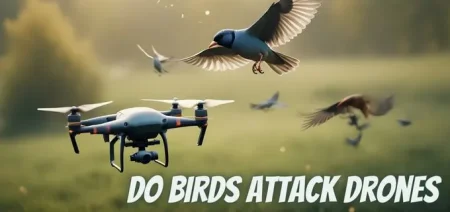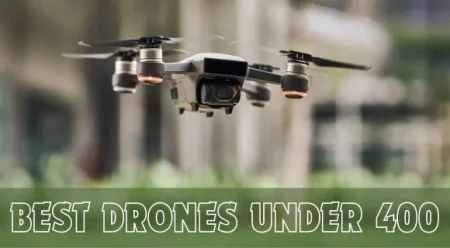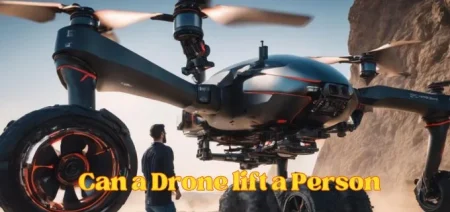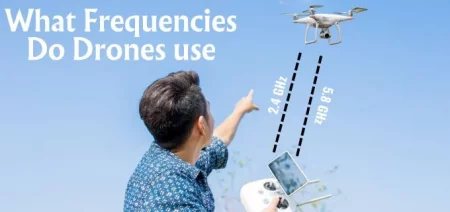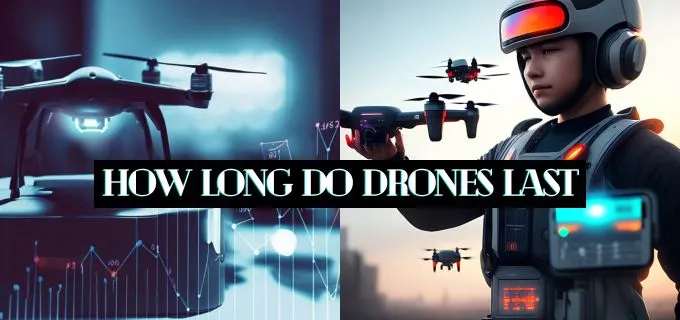
Drones are attractive and expensive gadgets that have captured the attention of many enthusiasts and professionals’ attention. They have revolutionized how we capture images and videos, and their applications continue expanding rapidly. From aerial photography to surveying, drones have become essential for many industries.
How Long Do Drones Last
But how long do drones last? The lifespan of a drone is a crucial factor to consider, especially if you’re planning to use it for commercial purposes. This all-inclusive guide will equip you with the necessary information you need to know. So, let’s get started!
In most cases, the drones can last for two years or more before any significant deterioration in performance or functionality occurs. However, this assumes the drone has not experienced any crashes or mishaps that could cause damage.
Understanding Drone Lifespan
Drones are complex machines with various components that work together to achieve their intended purpose. A drone’s lifespan refers to how long it can operate correctly and efficiently before it becomes obsolete or unusable.
Several factors affect the lifespan of a drone, including its battery, motor, propellers, environment, and usage. Let’s take a closer look at each of these factors and how they impact the lifespan of a drone.
Factors that Affect Drone Lifespan
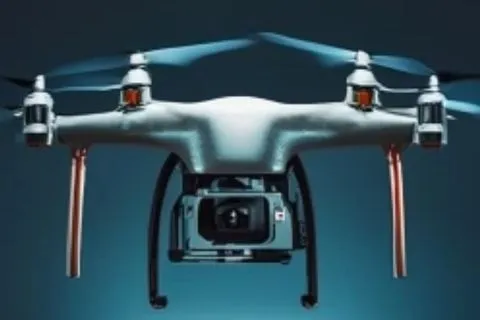
1. Battery
A drone’s battery is an important component that plays a significant role in its overall lifespan. The battery’s lifespan is measured in charge cycles, the number of times it can be fully charged and discharged before it loses its ability to hold a charge. Lithium-Polymer (LiPo) batteries, commonly used in drones, typically have a lifespan of 300-500 charge cycles.
We have written a detailed article about drones’ battery lifespan; you can read it here.
2. Motor
The motor is another essential component of a drone that impacts its lifespan. The motors are responsible for propelling the drone in the air, and their lifespan depends on various factors, including the quality of the motor, the drone’s weight, and usage frequency.
Motors can wear out over time, and signs of wear and tear include decreased efficiency, increased heat output, and unusual noise. Regular maintenance can extend the life of motors, such as lubricating the bearings and keeping them clean.
3. Propellers
Propellers are the part of the drone that generates the lift needed to keep the drone in the air. Propellers can get damaged over time due to crashes or general wear and tear, significantly affecting the drone’s lifespan.
Factors that affect propeller lifespan include the quality of the propeller, the drone’s weight, and the environment in which it is used. Regularly inspecting the propellers for damage and replacing them when necessary can extend their lifespan.
4. Environment
The environment in which a drone is used can significantly impact its lifespan. The performance of a drone can be influenced by several factors, including temperature, humidity, and altitude, which can also lead to damage to its components.
For example, flying a drone in extreme temperatures or high humidity levels can cause battery damage, while flying a drone at high altitudes can cause motor and propeller issues.
5. Usage
The frequency and intensity of drone usage can also affect its lifespan. Flying a drone frequently or for extended periods can cause wear and tear on its components and significantly reduce its lifespan.
The type of usage can also impact the lifespan of a drone. For example, using a drone for commercial applications such as aerial photography or agriculture may result in faster wear and tear than recreational use.
Average Lifespan of Drones in Different Categories
The average lifespan of a drone varies depending on its category. Generally, consumer drones have a shorter lifespan than prosumer and professional drones.
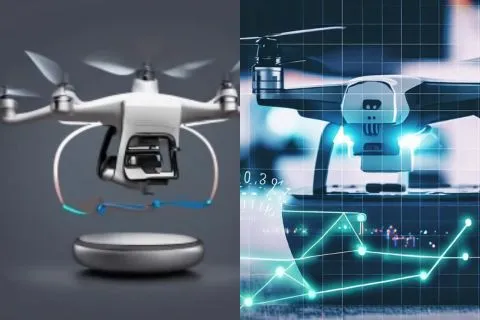
Consumer drones are designed for recreational use, with an average lifespan of 1-2 years. Prosumer drones are used for commercial and recreational purposes and have an average 2-3 years lifespan. Professional drones, used in industries such as film production and search and rescue, have an average lifespan of 3-5 years.
Which drones have the longest lifespan?
The lifespan of a drone depends on various factors, such as maintenance, usage, and environment. However, some drone models are known to have longer lifespans than others. Here are some drone models are known for their longevity:
DJI Phantom Series
DJI Phantom drones are known for their durability and reliability, making them popular among aerial photography and videography enthusiasts. DJI Phantom drones can last several years with proper maintenance and care.
DJI Mavic Series
DJI Mavic drones are compact, portable, and easy to fly, making them popular among drone pilots. They are also known for their long battery life, which helps to extend their lifespan.
DJI Inspire Series
DJI Inspire drones are professional-grade drones designed for commercial use. They are built to withstand harsh weather conditions and are known for their robust construction, making them a durable option for commercial drone pilots.
Yuneec Typhoon Series
Yuneec Typhoon drones are known for their stability, ease of use, and durability. They are built with high-quality materials and can withstand rough landings and crashes, making them a good choice for beginners and experienced drone pilots.
Autel Robotics EVO Series
Autel Robotics EVO drones are known for their long battery life, high-quality cameras, and durable construction. With proper care and maintenance, they can last for several years.
It’s important to note that the lifespan of a drone ultimately depends on how well it’s maintained and how it’s used. Following proper maintenance procedures and using your drone responsibly can help extend its lifespan and get the most out of your investment.
| Drone Model | Flight Time | Max Range | Max Speed | Estimated Lifespan |
| DJI Phantom 4 | 28 minutes | 5 km | 72 km/h | 3-5 years |
| DJI Mavic Pro | 27 minutes | 7 km | 64 km/h | 3-4 years |
| DJI Inspire 2 | 27 minutes | 7 km | 94 km/h | 4-6 years |
| Yuneec Typhoon H | 25 minutes | 1.6 km | 70 km/h | 2-4 years |
| Autel Robotics X-Star Premium | 25 minutes | 1.2 km | 64 km/h | 2-3 years |
| Parrot Bebop 2 Power | 30 minutes | 2 km | 60 km/h | 1-2 years |
| Holy Stone HS100D | 15 minutes | 500 m | 25 km/h | 1-2 years |
How long do DJI drones last?
DJI is one of the leading manufacturers of consumer and professional drones, known for producing high-quality and innovative products. The lifespan of DJI drones can vary depending on several factors, such as the amount and type of usage, maintenance practices, and environmental conditions.
Here is an estimated lifespan of some popular DJI drone models:
The lifespan of Mavic Pro 2:
The Mavic Pro 2 is a popular consumer drone known for its compact size, high-quality camera, and long flight time. The Mavic Pro 2 can last for around 2 to 3 years or approximately 3000 flight hours with proper maintenance and usage.
How long does Phantom 4 Pro last:
The Phantom 4 Pro is a professional-grade drone often used for aerial photography and videography.
The lifespan of DJI Inspire 2 drone last:
The Inspire 2 is a drone intended for commercial applications, particularly in the film and television industry. It’s important to keep in mind that the lifespan of DJI drones may differ based on how they are used and maintained. Regular maintenance, such as cleaning, lubrication, and parts replacement, can help extend the lifespan of your DJI drone and ensure that it operates smoothly and safely.
How to Extend the Lifespan of Your Drone
There are several ways to extend the lifespan of your drone and keep it operating efficiently for as long as possible. Here are some tips to help you maximize your drone’s lifespan:
1. Fly in Safe Conditions
Flying your drone in safe conditions, such as calm weather and open spaces, can reduce the risk of accidents and crashes. To prevent damage to your drone and extend its lifespan, it’s best to refrain from flying in harsh weather conditions like strong winds, rain, or snow
2. Practice Safe Flying Techniques
Learning and practicing safe flying techniques can reduce the risk of crashes and minimize the wear and tear on your drone’s components. Following are some important aspect that you need to consider:
3. Clean Your Drone Regularly
Cleaning your drone after each flight is an essential preventive maintenance practice. To clean the exterior of your drone and get rid of any dirt or debris, use a soft cloth that’s free of lint. Make sure to clean the camera lens as well to ensure your footage remains clear and free of smudges.
4. Perform Regular Maintenance
Regular maintenance can significantly extend your drone’s lifespan and ensure it operates efficiently. Clean the drone regularly, inspect the components for damage, and promptly replace any worn or damaged parts.
Conduct a Visual Inspection
A visual inspection of your drone can help you identify any signs of wear or damage. Check the drone’s exterior for cracks, dents, or scratches, and examine the gimbal and camera for any misalignment or damage. Look for any signs of wear and tear, such as frayed cables or loose wires.
Check for Loose Screws
Vibrations during flight can cause screws to loosen over time, leading to instability and reduced performance.Make it a habit to inspect for any loose screws on a regular basis and tighten them if needed.
However, be careful not to overtighten the screws, as this can cause damage to the drone’s frame or components.
Examine the Propellers for Damage
Propellers are essential components of your drone’s flight system, and any damage can lead to reduced performance or even a crash. Regularly examine the propellers for any signs of wear, such as cracks or nicks, and replace them if necessary.
Inspect the Motors
The motors provide the power necessary for your drone’s flight. Regularly inspect the motors for any signs of damage, such as bent or broken motor shafts. Additionally, check that the motors are operating smoothly and that there are no unusual sounds or vibrations during flight.
5. Upgrade Your Drone’s Components
Upgrading your drone’s components, such as the motor, battery, and propellers, can improve its performance and extend its lifespan. However, ensure the upgrades are compatible with your drone’s model and specifications before making any changes. Using incompatible parts can lead to damage and reduced lifespan.
When upgrading the battery, choose a high-quality battery with a higher capacity than the original one. It will increase the drone’s flight time and reduce the times the battery needs to be charged, ultimately extending its lifespan. Similarly, upgrading to higher-quality propellers and motors can improve the drone’s efficiency, leading to a longer lifespan.
6. Store Your Drone Properly
Storing your drone correctly can significantly impact its lifespan. When not in use, store the drone in a cool, dry place, away from heat sources or direct sunlight. If possible, store the drone in a case to protect it from dust, moisture, and other elements that can cause damage.
7. Avoid Overworking Your Drone
Overworking your drone, such as flying it for extended periods or too aggressively, can reduce its lifespan. Avoid pushing your drone beyond its limits; give it ample time to rest and cool down between flights.
8. Keep Your Firmware Up-to-Date
Manufacturers frequently release firmware updates for their drones, which can improve performance and fix bugs. Keeping your drone’s firmware up-to-date can help extend its lifespan by optimizing its performance and ensuring it operates efficiently.
How Environment and Usage Factors Affect the Drone LifeSpan
The environment in which you operate your drone and how you use it can significantly impact its lifespan. Here are some factors to consider:
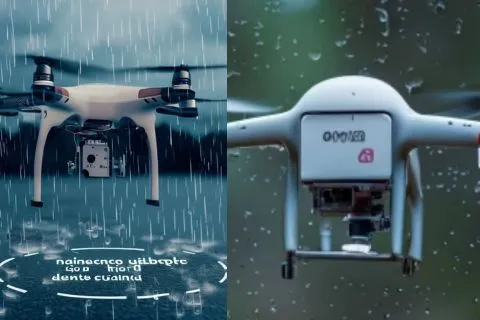
1. Temperature
Extreme temperatures can damage your drone’s components and reduce its lifespan. Always check the temperature range recommended by the manufacturer before flying your drone. Avoid flying your drone in extreme heat or cold conditions, as it can lead to battery failure, motor malfunction, and other issues.
2. Moisture
Moisture can cause irreparable damage to your drone’s electronic components. Avoid flying your drone in rainy or humid conditions. If you must fly in such conditions, use a waterproof casing to protect your drone’s electronics.
3. Wind
Strong winds can make it challenging to control your drone, leading to crashes and damage. Avoid flying your drone in windy conditions or in an area sheltered from the wind. If you must fly in windy conditions, ensure your drone’s propellers are in good condition and powerful enough to handle the wind.
4. Altitude
The altitude at which you fly your drone can also impact its lifespan. Higher altitudes require more power from the drone’s battery, reducing its flight time and lifespan. If you fly your drone at high altitudes regularly, consider upgrading the battery to a higher capacity or using a drone with a more powerful motor.
5. Flying Style
Aggressive flying styles can stress your drone’s components excessively, leading to damage and reduced lifespan. Avoid aggressive maneuvers such as sudden acceleration, sharp turns, and abrupt stops. Fly your drone in a controlled manner and avoid overworking it.
6. Flight Hours
Like any electronic device, your drone has a limited lifespan. The more you use it, the quicker its components will wear out. Keep track of flight hours and follow the manufacturer’s recommendations for regular maintenance and component replacement.
7. Proper maintenance:
Regularly clean your drone and its components, replace worn-out parts, and follow the manufacturer’s recommendations for maintenance.
8. Upgrades:
Upgrade your drone’s components, such as the battery, motor, and propellers, to improve its performance and extend its lifespan.
9. Firmware updates:
Keep your drone’s firmware up-to-date to improve its performance and fix any bugs. It can improve performance, fix bugs, and add new features. It’s essential to keep your drone’s software and firmware up to date to ensure it functions correctly.
By considering these environmental and usage factors, you can help extend the lifespan of your drone and ensure that it continues to operate efficiently for as long as possible.
How long do drone motors last
The lifespan of drone motors can vary depending on several factors, such as the quality of the motor, the amount and type of usage, and the environmental conditions. However, brushed drone motors typically range from 1500 to 5000 hours. In contrast, brushless motors can provide up to 10,000 hours of flight time before any performance issues arise.
It’s important to note that the lifespan of drone motors can be affected by the type of flight, such as aggressive or high-speed maneuvers, and exposure to moisture, dust, and other environmental factors. Additionally, poor maintenance practices, such as failing to clean the motors or lubricate them, can also reduce the lifespan of drone motors.
How Long Do Drones Last in the Air?
The amount of time that a drone can stay in the air, also known as flight time, can vary depending on several factors, such as the drone model, the size and capacity of the battery, the weight of the drone, and the flying conditions.
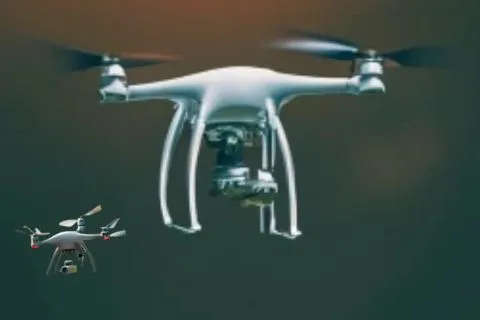
Most consumer drones have flight times ranging from around 15 to 30 minutes. However, professional-grade drones may have longer flight times, typically 30 to 45 minutes. It’s worth noting that flight times can also be affected by factors such as wind speed and temperature and the amount of weight the drone is carrying, such as a camera or other equipment.
It’s important to follow some best practices to maximize flight time, such as:
- Charge the Drone battery fully before flying
- Fly in optimal weather conditions, such as low wind and mild temperatures
- Fly in areas with minimal interference, such as away from crowded or urban areas
- Remove any unnecessary equipment or attachments that may weigh down the drone
- Use a battery with a higher capacity, or consider carrying a spare battery for longer flights.
FAQs:
What is the lifespan of a drone?
The lifespan of a drone can vary depending on factors such as usage, maintenance, and environmental conditions. Typically, most drones are designed to provide 150-800 flight hours or around one to two years of service life.
Can a drone fly for 2 hours?
A drone’s flight time duration depends on factors such as battery life, drone weight, and environmental conditions. Some advanced drones with longer battery life can fly for up to 30 minutes, while others can fly for 45 minutes or more. However, it’s unlikely that a drone can fly for 2 hours without requiring a battery swap or recharge.
Why are DJI drones so expensive?
Due to their advanced features and capabilities, DJI drones are often more expensive than other brands. DJI invests heavily in research and development to create high-quality products that offer a superior flight experience. Additionally, the cost of manufacturing and components used in DJI drones is typically higher than other brands, contributing to the overall cost.
When should I replace my drone?
You should consider replacing your drone if you notice any signs of damage, such as cracks or breaks in the frame, or if the drone is not performing as well as it once did. Additionally, if your drone has exceeded its expected lifespan or is no longer supported by the manufacturer, it may be time to replace it.
How long does a solar-powered drone last?
The lifespan of a solar-powered drone can vary depending on factors such as usage and maintenance. However, solar-powered drones have the potential to provide longer flight times than traditional battery-powered drones, as they can recharge while in flight. Some solar-powered drones have been designed to fly for up to several days or weeks as long as they are exposed to enough sunlight to recharge their batteries.
Conclusion
The lifespan of a drone depends on several factors, including maintenance, usage, and environmental conditions. While there is no definitive answer to how long a drone will last, it is possible to extend its lifespan through regular maintenance, careful usage, and upgrading components when necessary.
By following the tips and guidelines in this article, you can maximize the lifespan of your drone and get the most out of your investment. Whether you are a hobbyist or a professional, understanding drone lifespan is essential for enjoying this exciting technology.
So, take care of your drone, stay safe, and enjoy the incredible views and experiences that this technology can provide.

